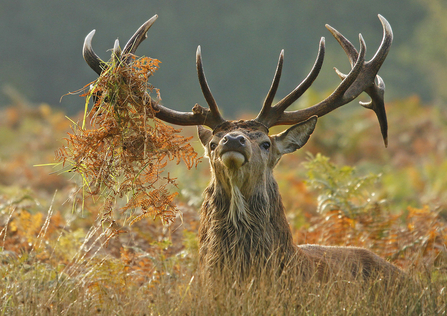The Pirbright Range Danger Area (RDA) is only 25 miles from central London in one of the busiest parts of the country, yet it is an unspoilt haven, home to threatened and rare species. There are no paths, no people and no dogs; it is truly Surrey’s last wilderness.
The land was originally bought by the government in 1877 and has remained almost undisturbed ever since because of its role in military training at the Defence Infrastructure Organisation’s (DIO) Pirbright range complex and as a safe area in case of overshooting at the National Shooting Centre at Bisley. In 1972 the public were finally excluded from the site by a 14km security fence. Within this is now a thriving wildlife community.
The fire problem
Without formal management Pirbright would normally transition to scrub and eventually woodland, but its heathland has remained because of a series of large fires. With ample vegetation providing fuel and the emergency services unable to enter, fires have regularly spread wide and burned long, threatening local homes, stretching the emergency services and incinerating wildlife and habitat. Eventually, changes in approach by both military and fire services reduced the number of incidents, but the lack of fire brought its own problems, allowing scrub to encroach. The normal management response is to mow, cut trees, strip turf and graze with domestic livestock, but access restrictions prevented this. Without the option to stand aside and allow the site to turn into secondary woodland, one of the most exciting conservation projects in the UK was conceived.
Beginnings
Inspired by the beneficial effects of deer on other heathland sites, Defence Estates, Natural England (NE), Defence Deer Management, RSPCA, Defra, the Deer Initiative, consultant deer specialists and Surrey Wildlife Trust met regularly from 2005 onwards. In 2006 SWT agreed to manage the MOD’s Defence Training Estate in Surrey for habitat conservation. 2007 saw the creation of the SWT grazing team and a green light from Defra. When NE, DIO and SWT provided resources, the works could begin:
• 5.1km of new Tornado wire, solid knot deer fencing
• 5 deer grids
• 20 culverts in stream and ditch exits
• 45 badger gates
• 11km of ground-proofing to the existing security fence
• 5km of raised razor wire coil so stags would not entangle their antlers
The animals arrive
SWT bought its first 22 red deer hinds in March 2010 from Bailing Hill Deer Farm in Warnham. Soon eight calves were running with them. In September we bought two stags to cover the hinds during the October rut. Since the gates of their holding paddock opened the herd has been under constant remote surveillance and carefully managed. GPS collars on two hinds and both stags allow us to monitor dispersal patterns, behaviour, feeding habits and response to seasons and stimuli. Since 2010 the herd has grown to 160 adults and their following calves.
Vegetation monitoring has found that the impacts of deer grazing, browsing and trampling have been almost universally positive. There have been significant increases in lichens yet decreases in bracken and scrub. In the wet heath sphagnum species and round-leaved sundew have flourished. And we have seen more species diversity and positive indicators in the valley mire.
Improving habitat
When the project started much of the site was in unfavourable declining SSSI condition. NE resurveyed in 2016 and reported that the dry heath, wet heath and mire met all targets for habitat condition. Pine, birch and common gorse appeared to be under control and there was high structural diversity. The site also continued to support large numbers of threatened ground-nesting bird species. As a result, NE moved the area into favourable condition. Deer browsing has opened up vistas, hooves have created bare ground habitat for sundews and ground-nesting wasps, and wallows have made ephemeral ponds in wet heath and mire. Ten years on, this pioneer project is helping other land managers, including the Danish and German ministries of defence.
So the next time you pass Bisley remember that red deer are just over the hill – a reminder that these animals once roamed naturally across the Surrey heaths and testament to the work that has gone into looking after a very special area and its wildlife.


